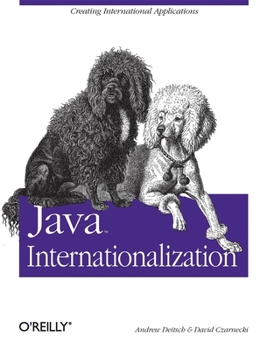Java Internationalization
Select Format
Select Condition 
Book Overview
On the Internet, there are almost no barriers against international commerce. Except for language. Unfortunately, most software is still written in English. Java Internationalization shows how to write software that is truly multi-lingual, using Unicode, a standard system that supports hundreds of character sets for most modern languages and many ancient ones. English-only software is already obsolete. Java Internationalization brings...
Format:Paperback
Language:English
ISBN:0596000197
ISBN13:9780596000196
Release Date:April 2001
Publisher:O'Reilly Media
Length:462 Pages
Weight:1.65 lbs.
Dimensions:0.9" x 7.0" x 9.3"
Customer Reviews
5 ratings
The "bible" on this topic
Published by Thriftbooks.com User , 23 years ago
There are three ways to handle internationalization of your Java applications. First, ignore it and give up all your non-English speaking customers. Second, write customized versions of your programs for each language you wish to support and live with a maintenance nightmare. Or third, take advantage of the many internationalization features built into Java. Fortunately, the internationalization features of Java are fairly simple to use and this book clearly explains how to apply them to your applications. The authors start with a description of the many writing systems in use through the world and discuss the many problems that these writing systems can cause for developers. The book then covers a wide range of topics: * how to use resource bundles to isolate locale specific data * formatting dates, numbers, and currency * handling searching and sorting issues for non-Latin alphabets (Japanese, Chinese, Hindi, etc.) as well as special cases within the Latin alphabet (an "a" with an umlaut is sorted with "a" in German but after "z" in Swedish) * handling languages such as Arabic and Hebrew that write from right to left * designing graphical interfaces to handle any writing system * building internationalized web sites If you plan on using the internationalization features of Java then you will definitely want to start with this book. The book is written for the intermediate to advanced Java programmer who needs to develop internationalized applications. The authors assume that the reader is unfamiliar with the issues involved with developing internationalized applications. (...)
Excellent explanation of Unicode, multi-lingual challenges
Published by Thriftbooks.com User , 23 years ago
The authors do a very good job of clearly describing the challenges of writing a multi-lingual capable applications. They do so for both client-based and web-based applications. I learned more than I thought I would about non-English languages and how vastly they can differ from our own. The real find is in their coverage of Unicode, explaining what it hopes to achieve and how it impacts your Java programming.I would say the next revision (if there's going to be one) would benefit by expanding font installation in other operating systems. Not too surprisingly, they cover only Windows, as it has the best unicode support today. However, TrueType support is possible on the Unixes, if you know how. I'd be curious to know how it would be possible on Mac OS X. The book would also benefit from expanded discussion on internationalizing web applications. It only covers display issues. The authors cite not wanting to cover issues surrounding web-based data entry and database operations because other authors discuss them, but those are relevant topics, IMO. After all, they discussed Swing-based data entry, so why not web forms? I was hoping for more complete coverage, as I am working on a I18N project now. But I'll have to hunt around for other books for the topics I could not read about here.Overall, this book is a great buy. Modern software developers would be foolish to not familiarize themselves with the I18N APIs in today's global economy.
How to write software that is truly multi-lingual
Published by Thriftbooks.com User , 23 years ago
In their Java Internationalization, multi-lingual authors Andy Deitsch and David Czarnecki successfully collaborate to show Java users how to write software that is truly multi-lingual by employing Java's highly sophisticated, cutting-edge internationalization facilities. The days of English-only software are numbered and the demands of ecommerce and internationalized software apps for new generations of software development compel software writers to expand beyond the limitations of language boundaries. A very highly recommended addition to all Java reference collections, Java Internationalization is essential for Java developers to bring themselves fully up to speed on the new generation of software development and able to write software no longer limited or restricted by language and cultural boundaries.
must have
Published by Thriftbooks.com User , 23 years ago
You must have this book for your understanding of Java Internationalization. For a more in-depth learning, I also recommend the new educational programs and online courseware at: http://www.tgpconsulting.com/courseware.htm used by companies such as Adobe, Apple, HP, Netscape, Oracle, Texas Instruments and universities and graduate schools such as Stanford.
Pre-release is very promising
Published by Thriftbooks.com User , 24 years ago
I have seen an early version of this book and have found it to be very useful. The examples are helpful and the writing is clear; it's about time a complete reference for software internationalization came out. Best for Java developers, but the concepts can be used anywhere.





